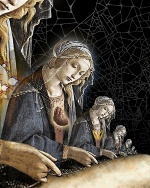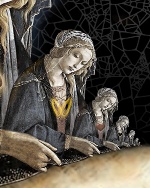Inspiration
About a week ago, my mother sent me a link to the Wikipedia article about Romanesco broccoli, with the subject "Fractals and Fibonacci food". In conversation afterwards she told me that she has always loved fractals.
I love them as well -- not only because they're beautiful and I enjoy mathematics, but also because they seem to describe how self-similar complex patterns appear at different scales in simple systems with feedback loops. Cell division. Cognition. Civilization.
So my thoughts turned to the similarities between mothers and children. The influences my mother has had on me, and that her mother had on her, and so on, likely to the beginning of time.
That was my starting point for "Madonna Matryoshka" my 2013 Mother's Day Card.
Symbolism
Madonna
I grew up in a household which was culturally Italian and nominally Catholic. I was baptised; I went through Communion and Confirmation; and though I consider myself firmly agnostic I still feel a greater connection to Catholicism than any other religion. I keep a palm leaf on my mantle, and light a candle for my grandmother in pretty much every Catholic church I visit.
A really big part of Catholicism is the veneration of Mary, the Madonna, mother of Christ. Artwork depicting Mary by herself or with the Christ child is generally called a Madonna. This is especially true of Italian works. So the core image of this piece is a Universal Madonna which encompasses both of the traditional depictions: she is simultaneously by herself and with her child, because her child retains many aspects of herself.
The ever-decreasing size from generation to generation is meant to recall the image of the nested Matryoshka dolls, because each generation "contains" the next generation within itself -- in a temporal sense, and, in the case of pregnancy, a literal sense. It is also an essential component of fractal forms that they contain smaller (yet not quite identical) copies of themselves, which in turn contain their own copies, ad infinitum.
So we can view a maternal line as a single meta-individual: a fractal form extending through time instead of space. (This, by the way, is a theme I'm currently exploring in my fiction, another creative outlet that my mother encouraged, so it's all delightfully self-referential.)
The largest, "outermost" figure is a combination of the Universal Mother figures Mary and Eve. The skeletal aspect emphasizes that her corporeal form is long dead; nevertheless, the heart of fire -- her spirit -- still illuminates her successive generations. This is not the Eve of Eden, but of Africa; the Mitochondrial Eve whose bones are perhaps still waiting to be discovered. The heart of fire is meant to recollect the sacred heart that Christ is normally shown with in Catholic representations. The ribs are an echo of the Eve mythology of creation -- yet here, it is Eve who is the creatrix.
Child
There are nine discernable figures in this image, each exactly half the size of the one preceding. Nine is the traditional number of Greek Muses, the goddesses of creativity and inspiration; they are also important figures in my writing, and one of my current projects explores many of the themes in this image.
Each "child" has the same appearance as its mother except for the heart, which is always different, because while mothers and children have similarities, they are all distinct individuals:
- La Prima Donna's heart, as explained above, evokes the Sacred Heart and the fires of creation, and represents immortal spirit.
- La Seconda's heart is made up of overlapping Mandelbrot sets, and represents the influence of intellect and learning, and the communication of knowledge down the generations. Fractals within fractals.
- La Terza's heart is an anatomical one, representing the corporeal body, and how we physically resemble our forebears.
- La Quarta's heart is the Lorenz Butterfly, a mathematical form related to fractals, chaos theory, and the butterfly effect named by Lorenz. It represents the small forces which cause divergence and difference between subsequent generations.
- La Quinta's heart is a traditional Valentine, representing maternal love. So are the hearts of La Sesta, La Settima, and La Ottava, although each are distinct.
- La Nona's heart is only one pixel in size, but I assure you that it is there.



The book is the Book of Ages, which all the figures are reading from and writing in, each teaching and influencing the next generation. The current year is given in Roman numerals at the bottom.
Elsewhere
Eve's "halo", and the backdrop for her and her descendants, is the Mandelbrot Set, perhaps the most widely-recognized fractal form in existence. The spikes of the fractal halo recall lightning bolts and electricity -- the "spark" which may have brought about the creation of the building blocks of life in primordial earth, and also the means by which the fictional Victor Frankenstein brought his own creation -- named Adam -- to life.
Outlining the halo is a clock face, again emphasizing the role that time plays in this particular fractal form. A clock also appears at lower left, inscribed with the simple formula that defines the Mandelbrot set. This is the formula which defines the line of Eve: self-similarity (mothers, children) iterated (down the generations) toward infinity.
Inset in Eve's halo is a cancellation stamp, a symbol of death and the [apparent] state of being defunct. Eve's influence on the future is from beyond the grave, in a temporal/causal rather than a supernatural sense.
Because different systems interact in complex ways to produce the appearance of randomness, another view of the Mandelbrot set is superimposed on itself in the background, lending complexity to what would otherwise be a quiescent mathematical sky.
The "spiderweb" in the black space behind the figures is a Voronoi fractal, a pattern which mimics the structure of leaf veins and other natural forms.
Off in the upper right quadrant, fractal stars and galaxies spin, because the forces that shape creation appear at all scales, everywhere. As Richard II says in The Lion in Winter: "We are the world in small."
In the upper right is the Italian phrase "Buona Festa Della Mamma", which you should be able to translate without my help.
Ingredients
As always, I used the GIMP for the editing, together with my Wacom digital tablet.
Nearly all of the ingredients were found on the web. Usually I did Google searches on the subject and picked the image(s) I most liked, regardless of where they came from. This is how the internet dreams.
The central motif was this picture of Botticelli's "Madonna of the Book". I have since found one of higher resolution, but I think the low-res version may have worked out better because of how it "softened" when expanded, receding into the background to allow the other shapes to come forward. I'm going to try an experimental cut with the hi-res version just out of curiosity.
I had to edit out the Christ child. I'm vaguely certain that that's a sin somehow.
La Prima Donna's skull was pieced together from two sources: this photo gave me everything but the lower jaw, which I got from this diagram. The trick was having everything perfectly aligned with the Madonna's head, and getting the teeth to line up.
La Prima's ribs were taken from a CD of anatomical clip-art. As with "Stork", I had to make some parts transparent to get exactly the look I was after.
La Prima's flaming heart was adapted from this.
La Seconda's heart of gold was built from layers of the same Mandelbrot set used for the sky, each layer 71% the size of the previous (as close as I could get to the square root of two) and slightly more opaque. I color-inverted the image, and happily got the perfect gold and white I was looking for.
La Terza's heart is the same one I used in The Fable of the Stork.
La Quarta's heart is this rendering of the Lorentz Butterfly, layered several times in a suitable mode to make the attractor glow.
The sky was this view of the Mandelbrot set, but behind it I superimposed a grayscale of this view in "divide" mode, to lend texture and complexity.
The stars and galaxies in the upper right were yet another view of the Mandelbrot set.
The clocks came from here.
The formula came from this TeX graphic in the Wikipedia article on the Mandelbrot set.
The inner halo is a cancellation stamp from a Phillipine post office.
The cobwebs behind the figures were this Voronoi fractal.
Soft glows were added throughout to separate the figures and unify the elements. Each figure is exactly 50% the size of the one to its left and desaturated as well: you can see this in the three superimposed figures on the right margin above.
"House M.D." Season 1 was playing in the background for significant parts of the work, especially the anatomical portions.











